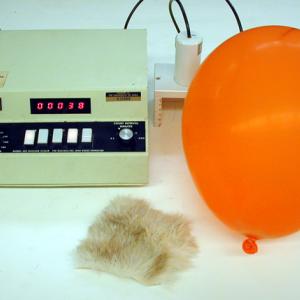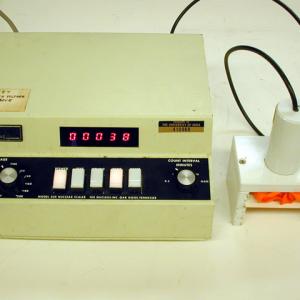College of Liberal Arts & Sciences
7D10.25 - Radioactivity of Dust - Radon
Blow up the balloon and rub it with the Cat's fur so that it has an electrostatic charge. Let is set in the room for at least an hour, but over night would probably be better. Pop the balloon and place it in the counter. You should be able to get counts that are about 3 to 4 times background. NOTE: If the balloon is placed in the sub-basement for several hours you should be able to increase the total count.
- Matthew Geske, Crystal Murray-Weston, Graham Lelack, "Measuring Atmospheric Radon Levels Using a Cloud Chamber", TPT, Vol. 60, #6, Sept. 2022, p. 498.
- Trevor M Willey and Jill A. Marshall, "Radioactive Balloon Measurements in Utah", TPT, Vol. 35, #8, Nov. 1997, p. 478.
- Carson A. Riland, "Environmental Radioactivity, Temperature, and Precipitation", TPT, Vol. 34, #4, Apr. 1996, p. 234.
- Thomas A. Walkiewicz, "The Hot Balloon (Not Air)", TPT, Vol. 33, #6, Sept. 1995, p. 344.
- Thomas A. Walkiewicz and David L. Wagner, "Radioactivity as a Function of Speed", TPT, Vol. 31, #5, May 1993, p. 260.
- James Cowie Jr. and Thomas A. Walkiewicz, "Radioactiveball", TPT, Vol. 30, #1, Jan. 1992, p. 16.
- Clifford Bettis and Carl Throckmorton, "What Teachers Should Know About Radon", TPT, Vol. 29, #6, Sept. 1991, p. 338.
- Patton H. McGinley, "Half-Live of Dust", TPT, Vol. 6, #6, Sept. 1968, p. 323.
- R. Cases, E. Ros, J. Zuniga, "Measuring Radon Concentration in Air using a Diffusion Cloud Chamber", AJP, Vol. 79, #9, Sep. 2011, p. 903.
- James A. Riley, "Student Measurement of Radon Gas Concentrations", AJP, Vol. 64, #1, Jan. 1996, p. 72.
- A, J, Howard, S. E. Carroll, and W. P. Strange, "A Simple System for Radon-In-Air Concentration Determinations", AJP, Vol. 59, #6, June 1991, p. 544.
- J. R. Cussenot and M. Fabry, "Undergraduate Experiment: Half-lifes Thorium 232 and Radon 220", AJP, Vol. 48, #9, Sept. 1980, p. 776.
- H. A. Smith, Jr., T. E. Ward, and J. Wesick, "Laboratory Study of the Radioactivity from Fission Products in Microscopic Fallout Particles", AJP, Vol. 46, #3, Mar. 1978, p. 279.
- P. H. McGinley, "Atmospheric Radioactivity", AJP, Vol. 41, #6, July 1973, p. 921.
- S-252: "Accumulating Radon on Balloon", DICK and RAE Physics Demo Notebook.
- W. Bolton, The Half-Life of a Radon Isotope(86Rn^220) (1)", Book 3 - Atomic Physics, Physics Experiments and Projects, 1968, p. 71-72.
- W. Bolton, The Half-Life of a Radon Isotope(86Rn^220) (2)", Book 3 - Atomic Physics, Physics Experiments and Projects, 1968, p. 73-74.
Disclaimer: These demonstrations are provided only for illustrative use by persons affiliated with The University of Iowa and only under the direction of a trained instructor or physicist. The University of Iowa is not responsible for demonstrations performed by those using their own equipment or who choose to use this reference material for their own purpose. The demonstrations included here are within the public domain and can be found in materials contained in libraries, bookstores, and through electronic sources. Performing all or any portion of any of these demonstrations, with or without revisions not depicted here entails inherent risks. These risks include, without limitation, bodily injury (and possibly death), including risks to health that may be temporary or permanent and that may exacerbate a pre-existing medical condition; and property loss or damage. Anyone performing any part of these demonstrations, even with revisions, knowingly and voluntarily assumes all risks associated with them.

